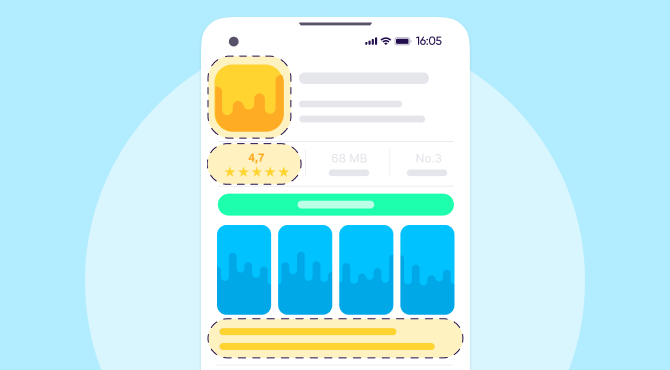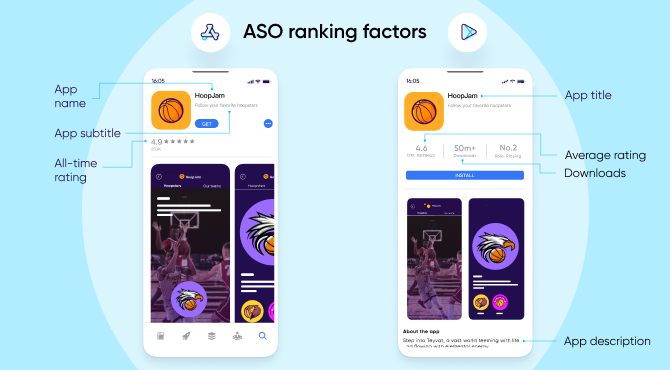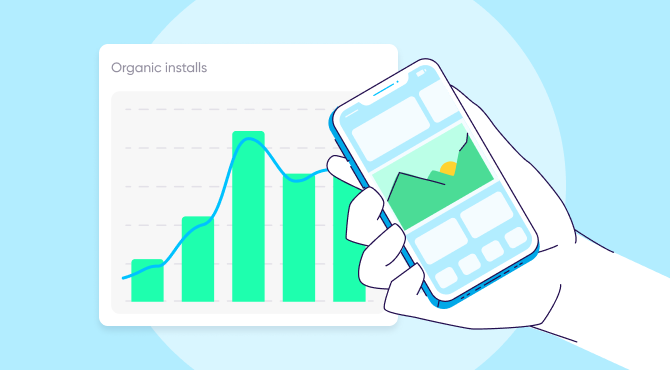
App store optimization (ASO)
What is ASO?
ASO is short for app store optimization. It refers to the ongoing process of increasing an app’s visibility in app stores to drive organic downloads, installs, and ultimately revenue.
Making an app visible in places like app store search results, top charts, and featured app lists is so important because the more exposure an app gets, the higher its chances of getting discovered by potential users.
ASO experts and app marketers work to boost an app’s visibility through a variety of tactics, including keyword optimization, app title and description optimization, app icon design, app store screenshots, app category selection, and more.
And while the tactics between different app stores — like Google Play and the App Store — may differ slightly depending on the search algorithms and functionality, at the end of the day, successful ASO is about optimizing towards real life users. It’s focused on clearly communicating value as well as providing optimized descriptions, engaging visuals, and actionable CTAs (calls to action).
Side note: if this all sounds a bit similar to SEO, that’s because it is! The difference is that ASO is for app store search engines and apps, with the goal of driving downloads, whereas SEO is for web search engines and websites, with the goal of driving traffic.
Why is app store optimization important for app marketers?

ASO is an essential part of an app marketer’s toolkit because:
- Organic users are often more engaged and loyal than paid users.
- Organic downloads and installs lower overall user acquisition costs (because ASO is free!).
- Organic visibility spans across markets and languages (when you choose to localize).
In fact, according to Google, half of all apps are discovered through app store searches. Read: if you’re not investing in ASO, you’re missing out on potentially the largest discovery channel around.
So what are you waiting for?
Investing in ASO means investing in:
- high-quality and relevant users
- increased organic app downloads
- lower user acquisition costs and continuous growth
- increased app revenue and conversion rates
- global audience reach
And that’s not all: ASO is also a handy tactic when it comes to things like increasing brand awareness, getting more (and better) reviews and ratings, and boosting user engagement.
How do apps get ranked?
App stores use complex algorithms in order to understand what an app offers, decide how relevant it is for a given query, and place it in search results.

While we don’t have full visibility into the ranking criteria, there are some factors that we know are more consequential. Here’s how they vary across the two main app stores:
| Apple App Store ranking factors: | Google Play ranking factors: |
| App name | App title |
| App URL | App description |
| App subtitle | n/a |
| Keyword field | n/a |
| In-app purchases | In-app purchases |
| Rating and reviews | Rating and reviews |
| Update cycle | Update cycle |
| Downloads and engagement | Downloads and engagement |
The above can loosely be summarized into four key components which you should consider when building out your ASO strategy:
- Perceived quality
- Freshness
- Brand reach/equity
- User value
What ASO tactics can you use to boost visibility?
As you can see from the table above, the core components of any ASO strategy center around optimizing the following elements:
- App name or title
- Keywords
- App description
- Downloads
- Ratings and reviews
- Updates
For a more in-depth look at how to optimize these elements, check out chapters 3 and 4 in our ASO guide.
How do you measure ASO results?
Measuring results starts with setting clear KPIs. While number of app downloads is the most obvious metric you’ll want to measure, there are other metrics influencing your app’s ranking. These include visibility, conversion rate, user growth, user feedback sentiment, and monetization.
Let’s break it down:
- Visibility — measure keyword, top chart, and category rankings as well as similar and featured app listings.
- Conversion rate — measure click-through rate (CTR) and click to install (you can see this info in the app store or with an MMP.
- User growth — measure installs, organic uplift, daily/monthly active users (DAU/MAU), and retention rate (you can see this info using an MMP).
- User feedback sentiment — there are customer tools to measure this, but you can also check the pulse of your reviews inside the app store.
- Monetization — measure revenue, average revenue per user (ARPU), and lifetime value (LTV). Again, an MMP can help you here.
For a deep dive into ASO metrics and KPIs, check out this post.

Do you need an MMP for ASO?
An MMP (mobile measurement partner) is handy when it comes to the metrics mentioned above. They can also help you understand things like the effectiveness of your ASO strategies, which keywords and campaigns are driving traffic and installs, and which ones aren’t performing well.
You can then take these insights and tweak your ASO strategy to improve visibility, engagement, and ultimately, installs.
Thinking about adding an MMP to your tech stack? Check out AppsFlyer today.



